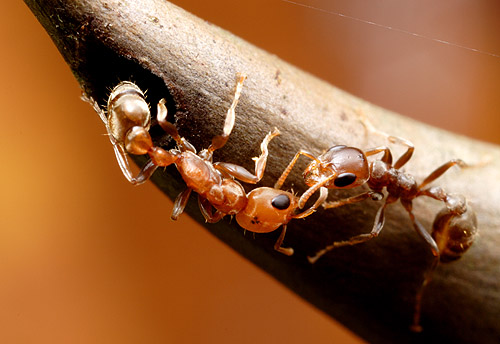A reader asks:
I also have a MP-E lens with the MT-24EX flash unit. I was curious to know something I didnât see you mention in your recent blog post about this setup.
Could you share any technical points regarding how you achieve the visible backgrounds with that lens? In general, I get very nice shots with everything beyond the focused subject completely blacked out.
Since dark areas in photographs are the bits that aren't sending light to the camera, it follows that getting a visible backdrop means applying light behind the subject.
Earlier, I wrote that the black backdrop in insect macrophotography with flash is often a sort of default setting. When bright flash is applied to a subject in the foreground, the background will fade to black as a matter of course. Consider this shot of Acacia ants taken in a Panamanian forest:
Although I snapped this picture during the day, the photo is mostly black. That's because little ambient light from the forest penetrated the small aperture I used to gain depth-of-field. Nearly all the light comes from the flash.
To bring up the background means either adding a second flash aimed behind the ants, or it means positioning something close enough behind the subject so that it is also lit by the foreground flash. In this case, I rigged a solution in the field:

A fallen leaf already suspended in the ants' tree is easily re-hung a few inches below it's original position to bring it behind the thorn of interest (photo by Jo-anne).

Shooting away- no more black background! The white tracing paper serves to soften the harsh light of the flash, while the orange leaf provides ambiance.
With a colorful leaf arranged a few inches behind the ants' thorn and reflecting the flash, the resulting photographs have a different tone:
I was lucky here that the thorny undergrowth provided an easy way to suspend a leaf. Paper clips are more reliable, and it's probably a good idea to carry a few into the field. In any case, the principle is the same: put something close enough behind the subject to reflect the flash.



Great tip, the light still looks extremely natural and soft with the leaf/paper behind. Great tip and excellent execution.
Wonderful tip! I assume the same concept would work with a plain ol' point and shoot?
Very cool tip, Alex. And how clever of you to carry an extra photographer in your pocket for those times when you need someone to take a picture of you while you take a picture of something else.
I have the exact same question! I use a point-and-shoot, and they are very bad with a good DOF, the flash is harsh too - is it possible to put a tissue paper around the flash and use? Gotta improvise when I cant afford an SLR ;)
Thanks so much for sharing this information Alex. Your solution definitely helped the picture background to soften and give a different feel to the last photograph versus the first.